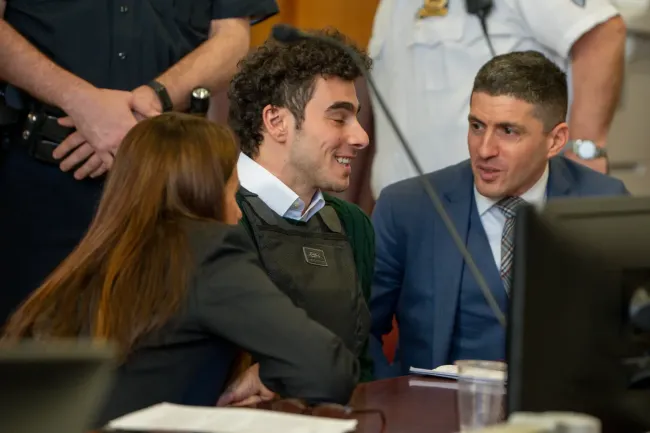Luigi Mangione Case: Understanding Mistrial Possibilities and Jury Nullification in a High-Profile Murder Trial
The case of Luigi Mangione, the 26-year-old accused of murdering UnitedHealthcare CEO Brian Thompson, has captivated the American public, transcending typical criminal proceedings to become a cultural flashpoint. Beyond the shocking allegations, the case has raised serious questions about fair trial guarantees, prosecutorial conduct, and the potential for jury nullification. This blog explores the complex legal landscape surrounding the Mangione case, examining potential grounds for a mistrial and the concept of jury nullification that might influence the ultimate outcome of this highly publicized case.
Who Is Luigi Mangione?
Luigi Mangione grew up in a prominent Maryland family. He was a standout student at an exclusive private school and later graduated from an Ivy League university. His life took a dramatic turn in December 2024, when he was accused of shooting and killing Brian Thompson outside a New York City hotel. Law enforcement described the incident as a targeted attack, and Mangione was arrested days later at a fast-food restaurant after a customer recognized him and called the police. He has been held without bail ever since.
Prosecutors allege the killing was premeditated and fueled by Mangione’s resentment toward the health insurance industry. He faces a long list of charges at both the federal and state levels, including murder, stalking, firearms offenses, and even terrorism. Mangione has pleaded not guilty to all charges and maintains his innocence.
Could There Be a Mistrial?
Mangione’s defense team has raised several issues that could potentially lead to a mistrial-a legal do-over, essentially-if the court finds that his right to a fair trial has been compromised.
Public Discussion of Evidence
One major concern is that high-ranking public officials, including the mayor and top NYPD officers, have publicly discussed evidence in the case before it was officially disclosed in court. Mangione’s lawyers argue that this could taint the jury pool and violate his right to a fair trial. They have even suggested that some evidence might be thrown out as a result.
The “Perp Walk” and Media Frenzy
Another issue is the way Mangione was transferred from Pennsylvania to New York. The scene was dramatic: Mangione, handcuffed and in an orange jumpsuit, was surrounded by armed officers as he was led off a helicopter. His lawyers argue that this “perp walk” was designed to generate media attention and could prejudice potential jurors against him.
Political Motives in Prosecution
The defense has also accused the Justice Department of seeking the death penalty for political reasons. They claim that local prosecutors did not recommend the death penalty and that the decision goes against legal precedent. Mangione’s lawyers have called the move a “political stunt” and argue that their client’s life is being used as a bargaining chip in a larger game.
What Is Jury Nullification?
As the trial moves forward, some legal experts have raised the possibility of jury nullification playing a role in the outcome. But what exactly is jury nullification?
Jury nullification happens when a jury acquits a defendant even though they believe the defendant broke the law. In other words, the jury deliberately ignores the law to send a message or because they believe the law is unjust. This is not something lawyers are allowed to suggest to the jury, but it is a power that juries have always had.
Historically, jury nullification has been used in cases where the law itself was seen as unfair-for example, during the era of slavery or Prohibition. In the Mangione case, some believe that jurors might be sympathetic to his alleged motives, especially given the widespread frustration with the healthcare system.
However, any juror considering nullification would have to weigh their personal beliefs against the severity of the crime and their legal duty to follow the law as instructed by the judge.
Public Reaction and Cultural Impact
The Mangione case has sparked a huge public response. Despite the serious charges against him, Mangione has become something of a social media folk hero. Supporters have projected “Free Luigi” murals in New York City and organized online campaigns across platforms like Reddit, Instagram, and TikTok.
This wave of support reflects broader social tensions, especially around healthcare access and corporate accountability. While most people do not condone violence, many are frustrated with the healthcare system and see Mangione’s actions as a symbol of that frustration.
What Happens Next?
As of now, Mangione’s case is making its way through both federal and state courts. His lawyers have asked for the federal trial to proceed first, especially since the federal government is seeking the death penalty. A trial date is expected to be set in late 2025, with the actual trial likely to begin in 2026.
The case is complicated by the fact that Mangione faces charges in multiple jurisdictions, and the legal teams are working hard to ensure that his rights are protected at every step.
The Bigger Picture
The Mangione case is more than just a murder trial-it’s a cultural moment that raises important questions about justice, fairness, and the role of public opinion in legal proceedings. As the case moves forward, the courts will need to carefully balance the need for a fair trial with the intense media and political pressure surrounding it.
No matter what the outcome, the Mangione case will be remembered as an example of how the legal system can become intertwined with broader social and political issues. For those following the case, it’s a powerful reminder that even in the most sensational trials, the principles of fairness, evidence, and impartial justice must always come first.
